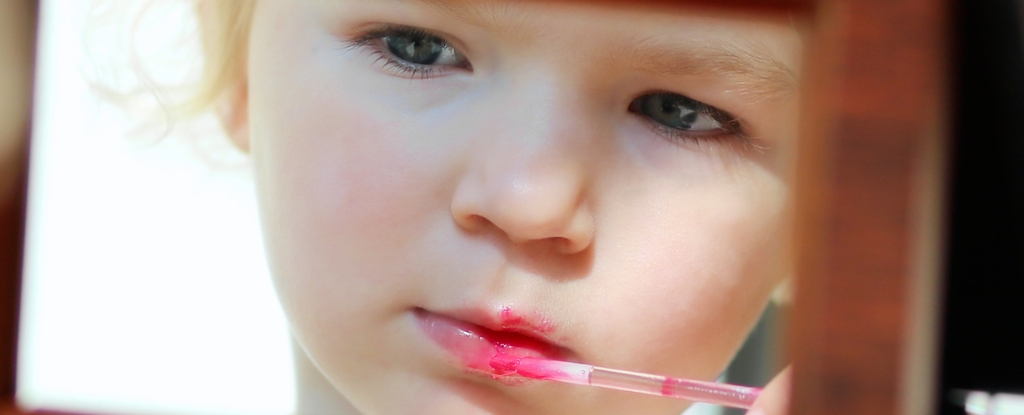
An investigation by the Times has revealed alarming findings regarding the use of adult cosmetic products on infants and young children. Babies and toddlers are increasingly exposed to items such as fragranced sprays, nail polish, and even black henna tattoos. While these products may seem harmless, scientific evidence suggests a different reality, highlighting significant health risks associated with their use on delicate young skin.
Infant skin differs markedly from that of adults. It is thinner, more absorbent, and still in the process of developing. This unique composition makes infants susceptible to immediate reactions like irritation or allergic responses. Furthermore, exposure to certain chemicals may pose long-term health risks, including hormone disruption. A study conducted in 2019 indicated that a child in the United States is taken to the hospital every two hours due to accidental exposure to cosmetic products.
The skin of newborns has the same number of layers as adult skin, but those layers can be up to 30% thinner. This reduced barrier allows harmful substances to penetrate deeper into tissues and the bloodstream more easily. Young skin also retains higher water content and produces less sebum, the natural oil that protects and hydrates the skin. As a result, children’s skin is more prone to dehydration, dryness, and irritation, particularly when exposed to adult-targeted fragrances and creams.
Health Risks of Cosmetic Ingredients
The investigation highlighted that bronzers and nail polish often contain harmful chemicals, including formaldehyde, toluene, and dibutyl phthalate. Toluene is classified as a neurotoxin, while dibutyl phthalate is an endocrine disruptor, capable of interfering with hormone function and potentially impacting growth, development, and fertility. The thinner skin of infants allows these toxic substances to be absorbed more readily, increasing the risk of adverse health effects.
Even minimal exposure to formaldehyde, found in everyday products and air pollution, has been linked to a greater incidence of lower respiratory infections in children. Just as concerning, a significant percentage of adults—approximately one in three—experience skin or respiratory issues after being exposed to fragranced items. Infants and young children, with their still-developing immune systems, face even greater risks.
Perfumes, which often contain alcohol and volatile compounds, can lead to dryness and irritation in the skin, manifesting as redness and discomfort. Some skincare products have been scrutinized for their potential to disrupt hormonal balance or trigger allergies. While many of these ingredients are permitted in regulated concentrations, researchers caution against the “cocktail effect,” where daily exposure to multiple chemicals could have cumulative impacts, especially on young, developing bodies.
Concerns Regarding Temporary Tattoos and ‘Natural’ Products
Temporary tattoos, particularly those made with black henna, have gained popularity, especially among children during holidays. Unfortunately, black henna can result in contact dermatitis and may contain para-phenylenediamine (PPD), a chemical that is permitted for use in hair dyes but not for direct skin application. Exposure to PPD can lead to severe allergic reactions and, in rare cases, cancer. Children who encounter PPD may also face heightened risks of severe reactions later in life if they later use hair dyes containing the same compound.
Interestingly, products marketed as “natural” or “clean” are not necessarily devoid of allergens. For example, propolis, commonly found in natural skincare lines, can cause contact dermatitis in up to 16% of children. A study assessing “natural” personal care items revealed that only 5.8% of 1,651 products on the US market were free from contact allergens. Labels like “dermatologically tested” do not guarantee safety; they merely indicate that the product underwent skin testing.
Experts emphasize that babies and young children are not just smaller versions of adults. Their skin is still maturing and is more vulnerable to irritation and the systemic effects of chemical exposure. Chemicals absorbed through the skin can enter the bloodstream and potentially affect various organs and biological systems throughout the body. Adverse reactions may appear as rashes, scaling, or itchiness, and in severe cases, can lead to blistering.
To safeguard the health of young children, medical professionals recommend minimizing the use of cosmetic products during the early years. Adam Taylor, Professor of Anatomy at Lancaster University, advises that when in doubt, it is best to keep skincare routines simple. Limiting what is applied to a child’s skin can significantly reduce the risk of irritation and long-term health issues.







